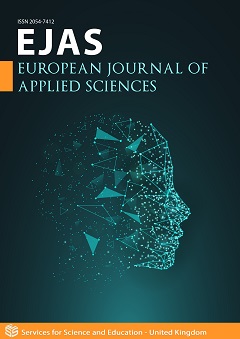Diurnal Variations of Total Electron Content over Equatorial Ionosphere: Ile-Ife South Western Nigeria
DOI:
https://doi.org/10.14738/aivp.93.10297Keywords:
TEC, equatorial ionosphere, solar radiation, radio wave.Abstract
The studies of equatorial ionosphere were carried out using data collected from Global Positioning System Scintillation Network and Decision Aid (GPS-SCINDA) facility at Ile-Ife, Nigeria (7.4667 N, 4.5667 E). The ionospheric parameters were computed every 60 seconds for a period of one month. The daily variabilities of Total Electron Content (TEC) values for the ionospheric experimental campaign were used for the computations and analysis. The daily maximum TEC values occur in the afternoon period, largely due to the large amount of solar radiation entering the ionosphere during while minimum TEC values were observed in the morning and evening periods. A maximum value of TEC for each day was around 30TECU to 40TECU. The greatest maximum TEC value was approximately 45TECU and it was observed at 13.00 hours and 17.00 hours respectively. The results obtained show a strong correlation between the solar radiation coming into an equatorial ionosphere and the variations in its Total Electron Content (TEC) values. The TEC values of equatorial ionosphere are sufficiently affected by the effects of solar activity.
References
Badeke, R., Borries, C., Hoque, M. M., & Minkwitz, D. (2018). Empirical forecast of quiet time ionospheric Total Electron Content maps over Europe. Advances in Space Research, 61(12), 2881–2890. https://doi.org/10.1016/j.asr.2018.04.010
Bhattarai, N., Chapagain, N. P., Adhikari, B., & Atlas, S. I. (2018). Study of Total Electron Content-TEC and electron density profile during geomagnetic storms. March.
Demissie, F., Mengistu, G., & Abraha, G. (2019). Climatology of quasi-two day oscillations from GPS-derived total electron content during 1999 – 2015. Advances in Space Research, 64(5), 1046–1064. https://doi.org/10.1016/j.asr.2019.05.048
Fayose, R. S., Babatunde, R., Oladosu, O., & Groves, K. (2012). Variation of Total Electron Content [ TEC ] and Their Effect on GNSS over Akure , Nigeria. 4(2), 105–109. https://doi.org/10.5539/apr.v4n2p105
Guo, Z., Yao, Y., Kong, J., Chen, G., Zhou, C., Zhang, Q., Shan, L., & Liu, C. (2021). Accuracy Analysis of International Reference Ionosphere 2016 and NeQuick2 in the Antarctic. Sensors, 21(1551).
Li, G., Ning, B., & Yuan, H. (2007). Analysis of ionospheric scintillation spectra and TEC in the Chinese low. 279–285.
Libo, L., Weixing, W. A. N., Yiding, C., & Huijun, L. E. (2011). Solar activity effects of the ionosphere : A brief review. 56(12), 1202–1211. https://doi.org/10.1007/s11434-010-4226-9
Lunt, N., Kersley, L., & Bailey, G. J. (1999). The influence of the protonosphere on GPS observations: Model simulations. 34(3).
M. Abdullah., N. Ya’acob., & Ismail, M. (2009). GPS Total Electron Content ( TEC ) Prediction at Ionosphere Layer over the Equatorial Region. World ’ s Largest Science , Technology & Medicine Open Access Book Publisher.
Mansilla, G. A. (2019). Geodesy and Geodynamics Behavior of the Total Electron Content over the Arctic and Antarctic sectors during several intense geomagnetic storms. Geodesy and Geodynamics, 10(1), 26–36. https://doi.org/10.1016/j.geog.2019.01.004
Memarzadeh, Y. (2009). Ionospheric Modeling for Precise GNSS Applications.
Ogwala, A., Olufemi, E., & Kumar, S. (2020). Total electron content at equatorial and low- , middle- and high-latitudes in African longitude sector and its comparison with IRI-2016 and IRI-PLAS 2017 models. Advances in Space Research. https://doi.org/10.1016/j.asr.2020.07.013
Prolss, G. W. (2004). Physics of the Earth’s Space Environment, An Introduction. Springer Verlag Berlin Heidelberg. https://doi.org/10.1007/978-3-642-97123-5
Singh, A. K., Das, R. M., & Shailendra Saini. (2019). Variations of total electron content over high latitude region during the ascending phase of 24th solar cycle. Advances in Space Research, 63(11), 3558–3567. https://doi.org/10.1016/j.asr.2019.02.017
Verhulst, T. G. W., & Stankov, S. M. (2017). Height-dependent sunrise and sunset : Effects and implications of the varying times of occurrence for local ionospheric processes and modelling. Advances in Space Research. https://doi.org/10.1016/j.asr.2017.05.042
Downloads
Published
How to Cite
Issue
Section
License
Copyright (c) 2021 Sola Fayose, Peter Chibuike Okoye

This work is licensed under a Creative Commons Attribution 4.0 International License.






